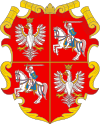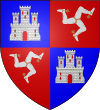Welcome to the Heraldry and Vexillology Portal!


Vexillology (from the Latin vexillum, a flag or banner) is the scholarly study of flags, including the creation and development of a body of knowledge about flags of all types, their forms and functions, and of scientific theories and principles based on that knowledge. Flags were originally used to assist military coordination on the battlefield, and have evolved into a general tool for signalling and identification, particularly identification of countries.
Heraldry encompasses all of the duties of a herald, including the science and art of designing, displaying, describing and recording coats of arms and badges, as well as the formal ceremonies and laws that regulate the use and inheritance of arms. The origins of heraldry lie in the medieval need to distinguish participants in battles or jousts, whose faces were hidden by steel helmets.
Selected article

The tradition and practice of heraldry in Poland dates from the 13th century. Although influenced by French and German heraldic practice, differs in a number of respects. One of the most striking is that a coat of arms does not belong to a single family. Many, sometimes hundreds of unrelated families may use a single coat of arms. Each coat of arms also has its own name. One side-effect of this unique arrangement was that it became customary to refer to members of the nobility (Polish: Szlachta) by both their family name and the name of their coat of arms. ( more...)
Selected flag

The national flag of Japan is a white flag with a large red disc (representing the rising sun) in the center. The flag's official name in Japanese is Nisshōki (日章旗, "sun flag") but the flag is more commonly known as Hinomaru (日の丸, "sun disc"). The Hinomaru was widely used on military banners in the Sengoku (Warring States) period of the 15th and 16th centuries. During the Meiji Restoration the flag was officially adopted for use as the civil ensign by Proclamation No. 57 on February 27, 1870 (January 27, Meiji 3 in the Japanese calendar). However, the flag was not adopted nationally until August 13, 1999, by the Law Regarding the National Flag and National Anthem.
Along with the national anthem Kimi ga Yo, the Hinomaru is considered a controversial symbol of the militaristic past of the country. Use of the Hinomaru was also severely restricted during the early years of the American occupation of the country after World War II, although restrictions were later relaxed. Japanese law did not designate any particular flag as the national flag from 1885 until 1999, although the Hinomaru was legally the national flag for the brief period from 1870 until 1885. Despite this, several military banners of Japan are based on the design of the Hinomaru, including the sun-rayed Naval Ensign. The Hinomaru was used as a template to design other Japanese flags for public and private use. ( more...)
Selected biography

John Philip Brooke Brooke-Little, CVO, FSA, FHS, (6 April 1927 –13 February 2006) was an influential and popular writer on heraldic subjects and a long-serving officer of arms at the College of Arms in London, England. In 1947, while still a student, Brooke-Little founded the "Society of Heraldic Antiquaries." This organization is now known as The Heraldry Society and is recognized as one of the leading learned societies in its field. He also served as the society's chairman for 50 years until 1997 and then as its President. ( more...)
Selected picture

The Grenville Diptych was produced between 1822 and 1839 for Richard Temple-Grenville, Marquess of Chandos the son of the first
Duke of Buckingham and Chandos. It shows 719
quarterings of the family, including ten variations of the
English Royal arms. The left panel of the diptych lists the quarterings.
Did you know...
- ...that the triskelion (pictured) in MacLeod heraldry originates from a belief that the clan's founder, Leod, was a son of a king of Mann?
- ...that the designer of the Coat of arms of New South Wales, William Gullick, was also responsible for heraldic influences in postage stamp design?
- ...that Albany, New York has a life-size version of its coat of arms that was sculpted by a local political cartoonist?
- ...that the Flag of El Hatillo Municipality, Miranda uses the same colours as the flag of Venezuela, though in a different order?
- ...that Moustache, a French poodle, is said to have been awarded a medal by Marshal Jean Lannes for saving a regimental flag at the Battle of Austerlitz?
Related portals
|
|
|
Heraldry Web resources
Authorities
- Belgium - The Council of Nobility, Flemish Heraldic Council and Council of Heraldry and Vexillology of the French Community
- Canada - Canadian Heraldic Authority and see also Public Register of Arms, Flags and Badges
- England, Wales, and Northern Ireland - The College of Arms
- Ireland - The Office of the Chief Herald of Ireland
- Netherlands - High Council of Nobility
- Portugal - Instituto da Nobreza Portuguesa
- Scotland - The Court of the Lord Lyon
- South Africa - South African Bureau of Heraldry
- Sweden - National Board of Heraldry, The National Archive
- United States Army - The United States Army Institute of Heraldry
Societies
- Greek Heraldry Society
- The Academy of Heraldic Science Czech republic
- The American College of Heraldry
- The American Heraldry Society
- The Augustan Society
- The Australian Heraldry Society Inc.
- Bulgarian Heraldry and Vexillology Society
- The Center for Research of Orthodox Monarchism
- Cambridge University Heraldic and Genealogical Society
- Chiltern Heraldry Group
- The College of Dracology
- Croatian Heraldic and Vexillologic Association
- The Finnish Heraldic Society
- Fryske Rie foar Heraldyk
- Hellenic Armigers Society
- Guild of Heraldic Artists
- Genealogical Society of Ireland
- Heraldry Research Institute (Japan)
- The Heraldry Society
- The Heraldry Society of Africa
- The Heraldry Society of New Zealand Inc.
- The Heraldry Society of Scotland
- The Heraldry Society of Southern Africa
- The Institute of Heraldic and Genealogical Studies
- The International Association of Amateur Heralds
- Italian Center of Vexillological Studies
- Lancashire Heraldry Group
- Macedonian Heraldry Society
- New England Historic Genealogical Society Committee on Heraldry
- Norwegian Heraldry Society
- Oxford University Heraldry Society
- Polish Heraldry Society
- Polish Nobility Confederation
- Real Academia Matritense de Heráldica y Genealogía - Royal Academy of Heraldry and Genealogy of Madrid
- Romanian Institute for Genealogy and Heraldry
- The Royal Heraldry Society of Canada
- The Russian College of HeraldryThe Russian College of Heraldry
- Serbian Heraldic Society
- Societas Heraldica Scandinavica
- Societas Heraldica Slovenica
- Swedish Heraldic Society
- Ukrainian Heraldry Society
- Royal Association Genealogical and Heraldic Office of Belgium
Vexillology
Software
- Coat of Arms Visual Designer web-based program
- Puncher Heraldry Program
- Blazonry Server - pyBlazon
- DrawShield - creates SVG shield or arms image from blazon
- CoaMaker - web-based tool
- Blazon95 and BLAZONS! 2000, older Windows applications
Texts
- Heraldry, historical and popular : with seven hundred illustrations (1863)
- A Complete Guide to Heraldry (1909)
Other
Wikimedia
The following Wikimedia Foundation sister projects provide more on this subject:
-
Commons
Free media repository -
Wikibooks
Free textbooks and manuals -
Wikidata
Free knowledge base -
Wikinews
Free-content news -
Wikiquote
Collection of quotations -
Wikisource
Free-content library -
Wikispecies
Directory of species -
Wikiversity
Free learning tools -
Wikivoyage
Free travel guide -
Wiktionary
Dictionary and thesaurus











